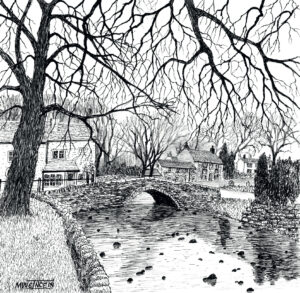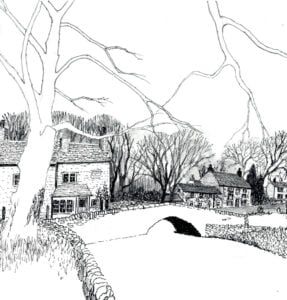
 Murray Ince paints the hub of Malham, the popular village in the Yorkshire Dales.
Murray Ince paints the hub of Malham, the popular village in the Yorkshire Dales.
For many years I have worked with traditional dip pens and ink, and with the more modern drawing pens. Recently, I have introduced the use of water-soluble graphite pencils into my work and I love the extra dynamic it gives me. It enables me to speed up the sketching process when working outdoors. It is an easy way of introducing a graphite grey wash, allowing subtle shading in my artwork. The modern drawing pens are a delight to use, eliminating the potentially messy ink bottle, easy to travel with and use on sketching trips.
In addition to the pens and water-soluble graphite pencils, I also use a water brush pen. For the touring artist who wishes to travel light, this is a great addition to the kit. It carries its own water in the pen itself, feeding the brush at the working end so that I can turn my graphite pencil work into grey-tone washes.
 My initial drawing of Malham village in Yorkshire is lightly done on a sheet of Frisk A4 Bristol Board using the Uni-ball – M5-450T and a mechanical pencil. The lines are kept as faint as possible, so once the drawing is completed with the pens, these pencil lines can be erased with the putty (kneadable) eraser if desired. I also often use a good quality Hot Pressed watercolour paper for these techniques, but the glassy smooth surface of the Bristol Board is great for pen and ink work.
My initial drawing of Malham village in Yorkshire is lightly done on a sheet of Frisk A4 Bristol Board using the Uni-ball – M5-450T and a mechanical pencil. The lines are kept as faint as possible, so once the drawing is completed with the pens, these pencil lines can be erased with the putty (kneadable) eraser if desired. I also often use a good quality Hot Pressed watercolour paper for these techniques, but the glassy smooth surface of the Bristol Board is great for pen and ink work.
 Next, I draw in the background trees, outlines of the major tree and buildings with the 0.1 Graphik Graphite colour pen. I also start establishing some of the middle distant trees with the 0.3 Pigma pen. At this stage, I gently shade in the ‘twiggery’ of the distant trees with a B grade watersoluble graphite pencil, using the waterbrush to go over it and turn it into a subtle grey wash. When this is bone dry I go over them with the 0.1 size Graphite colour pen, putting in more branches and twigs.
Next, I draw in the background trees, outlines of the major tree and buildings with the 0.1 Graphik Graphite colour pen. I also start establishing some of the middle distant trees with the 0.3 Pigma pen. At this stage, I gently shade in the ‘twiggery’ of the distant trees with a B grade watersoluble graphite pencil, using the waterbrush to go over it and turn it into a subtle grey wash. When this is bone dry I go over them with the 0.1 size Graphite colour pen, putting in more branches and twigs.
 I continue to build up the detail from distance to middle distance, mostly using the 0.05 black ink Pigma pen. The stonework of the cottages and tiles of the roofs are suggested rather than drawn: less is more. The windows are put in by hatching lines closely together leaving the white of the paper to indicate the glazing bars and frames and are only suggested rather than painstakingly drawn. Some of the darker trees and the underside of the bridge are drawn in with the 0.3 black pen. Meanwhile, the finer lines of the grass, stone wall and edging stones on the top of Malham bridge are drawn with the 0.05 pen. Detail with Precision
I continue to build up the detail from distance to middle distance, mostly using the 0.05 black ink Pigma pen. The stonework of the cottages and tiles of the roofs are suggested rather than drawn: less is more. The windows are put in by hatching lines closely together leaving the white of the paper to indicate the glazing bars and frames and are only suggested rather than painstakingly drawn. Some of the darker trees and the underside of the bridge are drawn in with the 0.3 black pen. Meanwhile, the finer lines of the grass, stone wall and edging stones on the top of Malham bridge are drawn with the 0.05 pen. Detail with Precision
 The next stage is putting in the detailing of the middle distance, all done with the 0.05 Pigma black ink pen. The stonework of Malham bridge and wall to the right is put in fairly loosely, indicating stone shapes. The grass on the left is a series of short, upright lines. The same method can be used for drawing fur.
The next stage is putting in the detailing of the middle distance, all done with the 0.05 Pigma black ink pen. The stonework of Malham bridge and wall to the right is put in fairly loosely, indicating stone shapes. The grass on the left is a series of short, upright lines. The same method can be used for drawing fur.
In this case, I draw from the top down so that the grass appears to be layered as it would in reality. I also start to draw in some of the reflection of the bridge and the stones in the river.
 Here I continue to establish the reflections of Malham bridge, right-hand wall and trees using linear strokes of the 0.05 sized black pen, which are kept parallel with the bottom edge of the paper. I also put in some more stones and their reflections.
Here I continue to establish the reflections of Malham bridge, right-hand wall and trees using linear strokes of the 0.05 sized black pen, which are kept parallel with the bottom edge of the paper. I also put in some more stones and their reflections.
 In the final stages, the big tree, its branches and twigs are drawn in with the 0.3 and 0.8 black ink pens. On the main trunk and branches, I use wiggly, short lines drawn up the tree trunk the way it grows. The lesser branches are put in with more solid looking colour, the lines being drawn closely together. I draw the fine twigs with the 0.05 pen.
In the final stages, the big tree, its branches and twigs are drawn in with the 0.3 and 0.8 black ink pens. On the main trunk and branches, I use wiggly, short lines drawn up the tree trunk the way it grows. The lesser branches are put in with more solid looking colour, the lines being drawn closely together. I draw the fine twigs with the 0.05 pen.
Lastly, I put in some shading with the water-soluble graphite pencil on the main tree and in the reflections, and finally erase any of the original pencil lines that are still visible.
Sadly Murray passed away in 2023 and this article is dedicated in his memory. We extend our heartfelt thanks to Murray Ince and his family for their unwavering support of the SAA and our members.
This article was originally published in Paint & Create, the magazine of the SAA, one of the many benefits of SAA Membership.